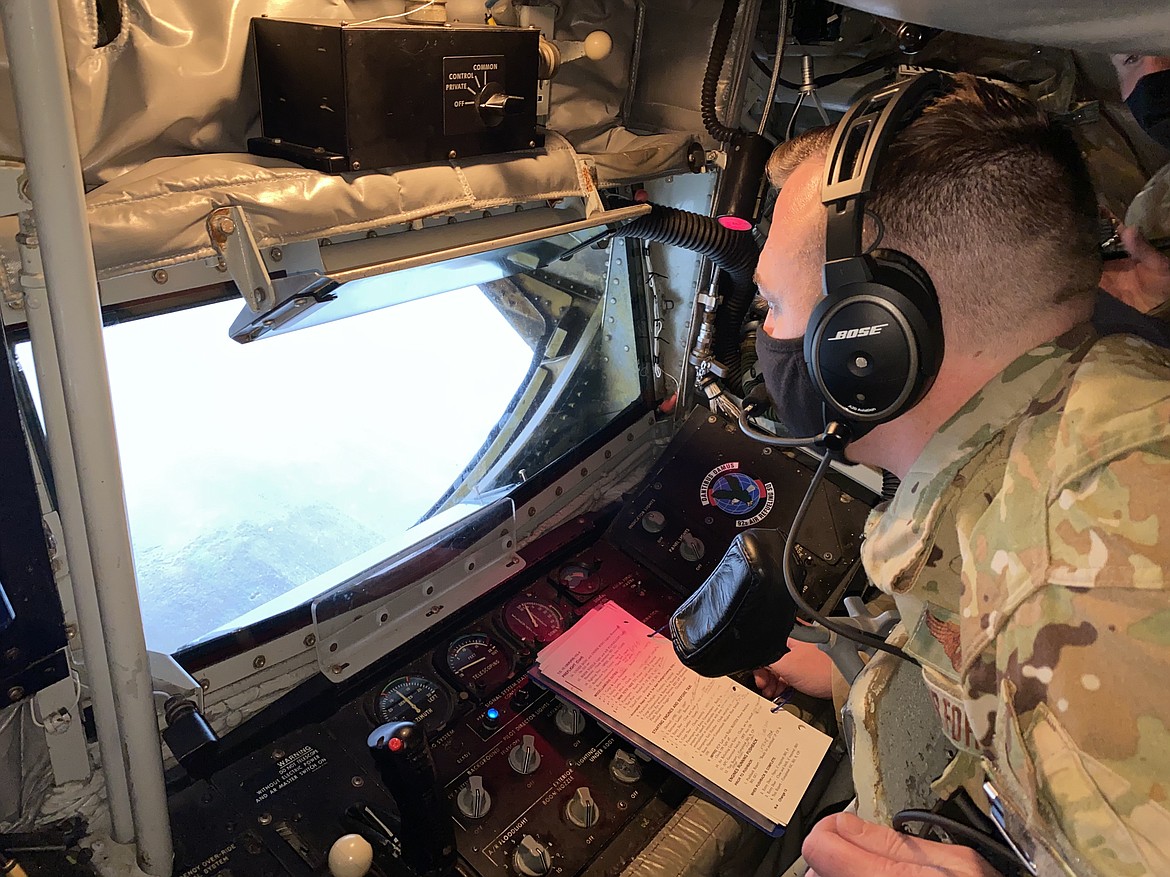Fairchild delivers fuel - and inspiration
MADISON HARDY | Hagadone News Network | UPDATED 5 years, 1 month AGO
SPOKANE - Twenty-seven thousand, five hundred feet in the sky Tuesday morning, the KC-135 Stratotanker and Fairchild Air Force Base's 93rd Air Refueling Squadron were doing what they have for 73 years: expanding the U.S. Air Force global reach.
Recognized as the Air Force's only Supertanker Wing, the Fairchild 92nd Air Refueling Wing celebrated its 73rd birthday by performing in-air plane refueling and pilot training exercises.
At the rear of the KC-135 Stratotanker - a large aircraft designed for transporting cargo - is the "flying boom," a tubelike feature that connects to planes and delivers jet fuel in a matter of minutes. While it can serve various aircraft, on Tuesday the 93rd squadron practiced on two C-17s flying over Idaho and Montana.
"Tankers get up there with receivers and meet at a point in space with closure rates of almost 1,000 miles an hour," said Major Stephen Steel, a pilot in training. "You're taking tiny objects in a giant sky, finding each other and joining together. When it works out, they roll up right behind you. It's beautiful and so smooth."
Senior Master Sergeant Ryan Clauss has served in the Air Force for 17 years. Before transferring to Fairchild two years ago, Clauss was stationed at Altus Air Force Base in Oklahoma, training American and international students about aerial refueling. Now in Washington, Clauss is an instructor to the four Fairchild refueling squadrons.
"If you talk about being the best Air Force in the world, that doesn't happen without air fueling," Clauss said. "We stretched the legs of every entity that is part of the U.S. Air Force. The tankers, in general, are a strategic measure to get assets in place at a moment's notice. Without air fueling, that would be very difficult."
The Air Force's ability to refuel active flights has improved dramatically since the late 1940s, Clauss said. Then, crew members risked their lives by climbing on the wings, tips, or tails of airplanes, Clauss said, passing a gas can and hose to nearby aircraft.
KC-135s have provided aerial refueling capability for the Air Force for over 60 years and has become an inspiration to other countries' aerial refueling and airplane designs. With four turbofans and a 130-foot-wingspan, the Stratotanker can carry about 200,000 pounds of gasoline to refuel allied aircraft on long-distance, overseas or lengthy missions.
"There are a few aircraft that can traverse long distances without air fueling, but for the most part, all the air fighters and some of the heavy aircraft that are hauling cargo or have a heavy load of bombs are going to need air fueling to get where they want to go," Clauss said.
Since instituted in 1942, Fairchild has become a vital contributor to the national defense. From acting as a World War II depot to a Strategic Air Command tanker and bombardment wing, the base has served the Air Force's needs of the time. Today, Fairchild is home to the Air Force's premier air refueling tanker base that supports the entire West Coast.
"(This flight) celebrates our birthday and service as the main part of everyday operations everywhere in the Air Force," 1st Lt. Savanah Koontz said. "We support every kind of plane in the Air Force, every kind of mission, and we are kind of unique in that aspect. We are so big and an integral part of the airport's mission."
A successor of the World War II 92nd Bombardment Wing, which bombed targets in occupied Europe and Nazi Germany in the 1940s, the Wing has long been a part of Strategic Air Command operations. Its birthday Tuesday signified the department's transition into aerial refueling Wing it is today.
The largest aerial refueling division globally, Fairchild and the 92nd Wing have undergone internal regime and aircraft performance improvements to expand their abilities and keep up with demands. By expanding squadron numbers - which touts over 420 members - to new KC-135 engines, communications, navigation, autopilot, and surveillance equipment, Fairchild is consistently changing the face of refueling.
"The most important piece is seeing the effect that Fairchild has. It's global, we're in multiple different locations every day, and they can rely on us to meet any need whenever they need it," Clauss said. "The Pacific is one of the biggest regions, and with that being such a large, vast amount of area, it needs a lot of tankers there to meet that need."
ARTICLES BY MADISON HARDY

CDA Tribe challenges redistricting
Says 'communities of interest' not served in new map
Coeur d'Alene and Shoshone-Bannock tribal leaders file suit against legislative boundaries

CDA Tribe challenges redistricting
Says 'communities of interest' not served in new map
Coeur d'Alene and Shoshone-Bannock tribal leaders file suit against legislative boundaries

CDA Tribe challenges redistricting
Says 'communities of interest' not served in new map
Coeur d'Alene and Shoshone-Bannock tribal leaders file suit against legislative boundaries









